Earlier Green Revolution saved India from hunger and now Organic Farming is trying to make that food healthy. Farming does not become organic just by changing the fertilizer or pesticide! Even today many farmers are confused about what is real organic farming?
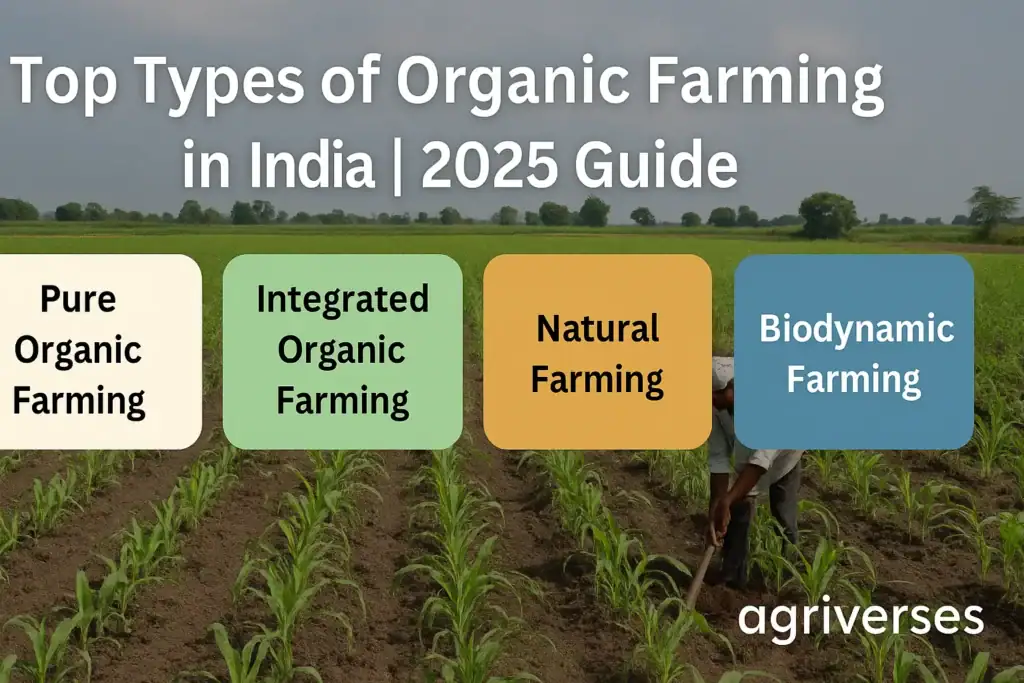
In this article, we will talk about different types of organic farming – which can make your farming more sustainable and profitable. And with examples to help you decide which methods are best for your farm.
You can check out my article on benefits of organic farming on agriverses.
Types of Organic Farming in India
There are many forms of organic farming, which are based on different input systems and approaches. Models like Integrated Organic Farming and Natural Farming are most popular in India.
To understand the basics, you can also check out, What Is Organic Farming? – Complete Guide for Beginners.
Organic farming in India can be broadly categorized into the following types based on practices and principles:
- A. Based on Input System
(These are mostly followed by ICAR, Agri Books, and Govt schemes)
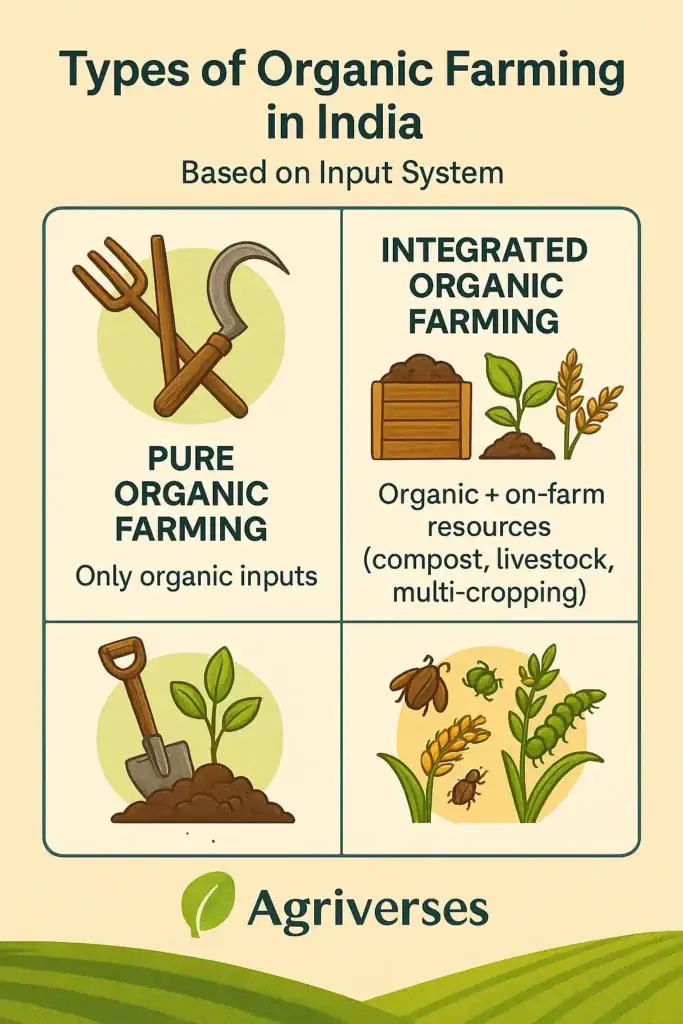
1. Pure Organic Farming
This is the strictest form — absolutely no chemical inputs. In this farming, only natural fertilizers (like compost, green manure,Jeevamrut, neem oil) and bio-pesticides are allowed. Everything that goes into the soil or plant comes straight from nature.
example:
Farmers who I know grow organic vegetables in Sikkim. They use only local seeds and local fertilizers and also use natural resources for production of crops. Their produce looks fresh and delicious. I like this .
Ideal Crops:
Like Leafy vegetables(spinach, methi), Medicinal herbs(tulsi, ashwagandha), Fruits(Papaya, guava)
Best for
- Small and marginal farmers in remote regions or hill areas. Especially the North-East region of India because natural resources are available.
- It is perfect for small land holdings and home gardens. Due to this, farm management has become an easy task for farmers.
- Those who want to export (because residue test is done there). Quality produce which attracts buyers.
- A farm where the risk of pollution or contamination is less.
Challenges:
- Yield becomes less in the beginning of the year, so I need deep knowledge and patience.
- Certification and input are expensive, Because theoretically it looks easy but in reality, certification processes are very slow and complicated.
- Risk of contamination from chemicals from outside is very high. Because everywhere uses chemicals and in organic farming the main demand is that no chemical is involved in any cycle of production.
2. Integrated Organic Farming (IOF)
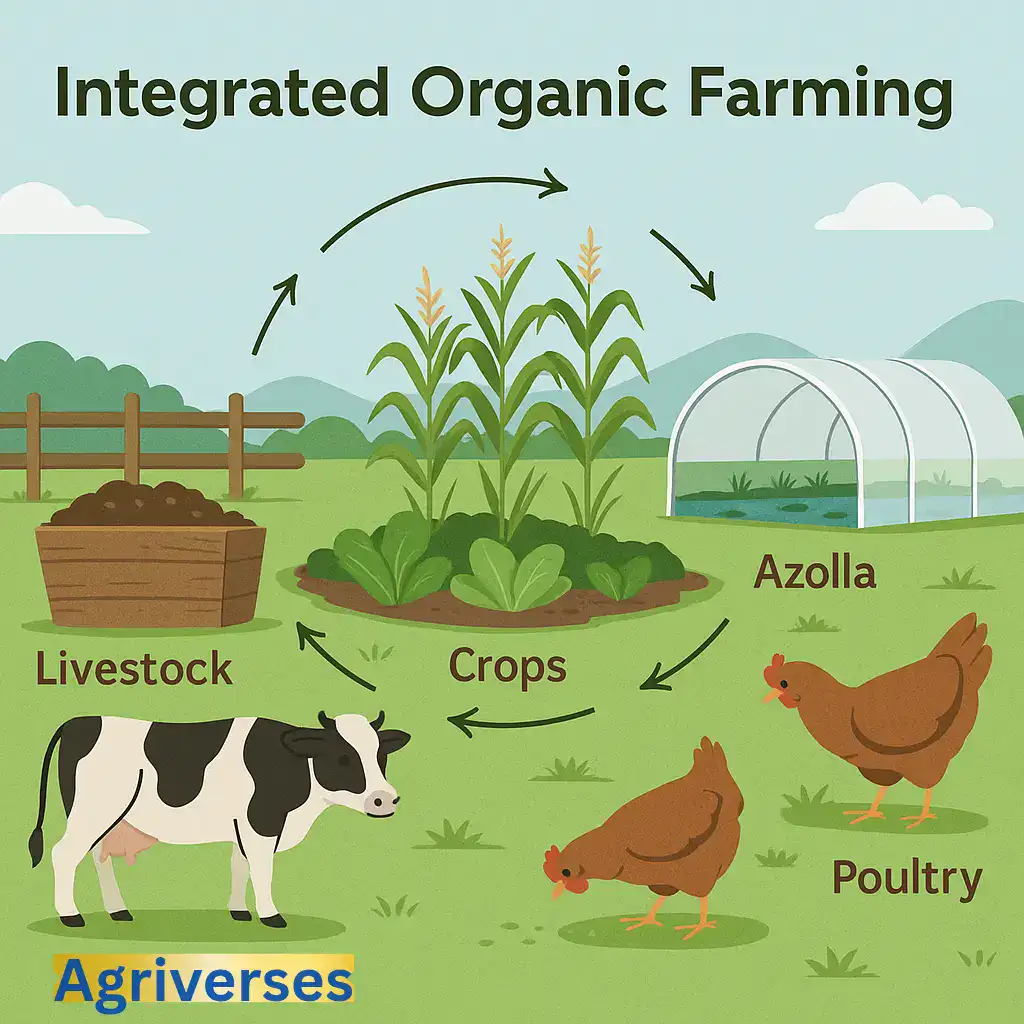
Now imagine a farm where everything is connected – crops, animals, fertilizers and fish. This is Integrated Organic Farming – in which the farmer prepares fertilizer, cattle dung, fodder and bio-inputs from his own farm.
This model is a balanced system where a natural cycle is created in which waste from one place becomes input at another place.
example:
Hari Singh ji from Pratapgarh, UP, grows wheat and masoor in his 1.5 bigha land, has an Azolla pond in the back corner, gets dung from a local cow which makes vermicompost, and since last year he has also started keeping some chickens. Everything is connected to each other!
Key Features and Benefits of Integrated Organic Farming
- “Fertilizer from cow, fodder from azolla, and poultry farming” – this is the magic of integrated organic farming. The waste from the field itself becomes fertilizer, and one system supports the other. Money is saved and the land remains healthy.
- “One farm, three sources of income” – when poultry, fish or goat farming is added to farming, then every month some or the other source of income becomes available for the farmer. This model is like a jackpot for small farmers.
- “Dependency on external inputs reduces” – By using the waste from your farm, the cost of purchasing chemicals or inputs from the market is eliminated. Your farm runs on your own resources.
Challenges and Solutions of Integrated Organic Farming
- Challenge 1: It is difficult to manage everything together
When farming is accompanied by livestock, fisheries and composting, both the work and the tension increase. Everything requires time and knowledge.
Solution:
Start small. First add just one or two components – like vermicompost or azolla along with farming. When you are comfortable, then only take the next step.
- Challenge 2: Lack of knowledge and training
Many farmers do not know how to grow azolla or how to make high-quality vermicompost from cow dung. Mistakes can also cause losses.
Solution:
Learn from free sources like Krishi Vigyan Kendras (KVKs), ATMA projects, and YouTube. Also get training from progressive farmers in your vicinity – practical knowledge is the real guru.
- Challenge 3: The need for initial investment
Initially some money is required – like making a shed, compost pit or preparing an Azolla tank.
Solution:
Subsidy can be obtained from government schemes like RKVY, Paramparagat Krishi Vikas Yojana (PKVY). Local NGOs also help. And remember – this is a one-time expense, the return is received every year.
- B. Based on Farming Approach or Philosophy
(Here Include the different well-known systems that fall under the organic umbrella)

1. Natural Farming (Zero Budget Natural Farming / SPNF)
The founder of this system is Subhash Palekar, who developed a chemical-free and cost-free model based on desi cows. Soil is brought back to life with the help of home remedies like Jeevamrut, Beejamrut, Neemastra. External inputs are not required in this, hence it is also called “Zero Budget”.
Today in Andhra Pradesh, this system is helping millions of farmers to become chemical-free. Soil health improves, water is saved, and expenses are also reduced – it is an absolutely sustainable model.
2. Biodynamic Farming
This is a slightly spiritual and regenerative model developed by Dr. Rudolf Steiner of Germany in the 1920s. It uses the position of the grains, cosmic calendar, and special “BD Preparations” (such as cow horn manure).
In India, grape farmers of Maharashtra have adopted this system – especially for export quality produce. They believe that it improves taste, shelf life and soil vitality.
3. Permaculture
Permaculture means “Permanent Agriculture”, which is based on a nature-inspired design system. This approach designs farming as an ecosystem – where water, trees, plants, and animals all support each other.
This system is perfect for small spaces, kitchen gardens, or urban farming. Some farms in Auroville (Tamil Nadu) have adopted it and set an example of self-sufficiency and zero-waste model.
4. Vedic / Traditional Farming
This system is based on India’s classical farming methods, which use cow-based inputs, lunar calendar, and Vedic rituals. Practices like Rishi Krishi, Homa farming, and Agnihotra are included in it.
This farming approach is not only focused on physical produce but also on spiritual purity and faith in the earth. This allows “dharma and farming” to go hand in hand.
The biggest advantage of these systems is that they make the farmer a part of a larger ecosystem. From input use to soil health and long-term sustainability – everything is deeply interconnected. Every farmer can adopt any of these models according to his thinking, problem and goal.
- C. Based on Emerging & Hybrid Methods
(These are new innovative or mixed systems that follow the core principles of organic)
1. Integrated Organic-Aquaculture Farming
This model is a great combo of organic farming and fish farming. In Paddy-cum-Fish systems, fish farming is done in the paddy fields itself – which provides both chemical-free grain and protein. This system is being used quite successfully in North-East India, especially in states like Assam and Manipur. It also makes efficient use of water and diversifies farm income.
2. Urban Organic Farming / Kitchen Gardening
People in cities have also embarked on the journey of organic farming – small farming in balcony, terrace or backyard. People are growing poisonous vegetables using compost bin, Jeevamrut and natural sprays. In cities like Pune, Bengaluru, “Ghar ki Kheti” has become a movement. This model not only provides sustainability but also mental peace!
Comparison Table: Types & Approaches in Organic Farming in India
| Type / Approach | Inputs Used | Scientific Basis | Certification Possible? | Suitable For | Example Regions / Uses |
|---|---|---|---|---|---|
| Pure Organic Farming | Only organic inputs | Basic organic principles | Yes | Small certified farms, export-focused units | Sikkim, Uttarakhand |
| Integrated Organic Farming | Organic + on-farm resources (compost, livestock, multi-cropping) | Low-input sustainable system | Yes | Small & marginal farmers | Punjab, UP, Bihar |
| Natural Farming (SPNF) | Jeevamrut, Beejamrut, cow dung-based inputs | Subhash Palekar’s Zero Budget model | Yes (as part of organic) | Low-budget, desi cow-based farms | Andhra Pradesh, Maharashtra |
| Biodynamic Farming | BD 500–BD 508, cosmic calendar, compost | Rudolf Steiner’s spiritual science | Yes | Spiritual & export-focused farms | Maharashtra (grapes), Himachal (apples) |
| Permaculture | Organic + eco-design principles | Bill Mollison’s ecological design concept | No standard, but practices align | Kitchen gardens, hobby farms, urban farms | Auroville (TN), eco-villages |
| Vedic / Rishi Krishi | Panchagavya, Agnihotra, lunar timings | Vedic literature, desi traditions | No | Spiritual/Traditional farming believers | Gujarat, MP, Tamil Nadu |
| Agroecology-Based Farming | Indigenous seeds, organic inputs | FAO-recognized, ecology-based system | Yes (under organic umbrella) | Farmer collectives, community farms | Odisha, Jharkhand, tribal regions |
| Urban Organic Farming | Compost, kitchen waste, neem-based sprays | Organic principles, DIY-friendly | No (usually personal scale) | Urban gardeners, schools, home growers | Bengaluru, Pune, Delhi rooftops |
Why Organic Farming is Gaining Popularity in 2025
- Organic farming in India is growing fast in 2025. Now, people are getting more health-aware and conscious about what is going into their plate, chemical-free food is becoming the obvious choice.
- Eco-friendly practices are being promoted, and global markets are opening doors wide for Indian organic produce.
- Reports show exports shot up by 34.6% last year, hitting around ₹5,500 crore. The U.S., EU, and Canada are among the top buyers. (Source)
- Support from NABARD and FSSAI is also helping farmers make the switch. For example, Maharashtra added 68,000+ hectares of fruit plantations under organic methods. (Source)
- Among all types of organic farming, Natural Farming and Integrated Organic Farming are catching on fast—thanks to their low-cost inputs and climate-friendly approach.
Conclusion
There are many types of organic farming in India, but Natural Farming and Integrated Organic Farming are most popular and successful at the ground-level. Natural farming is based on indigenous and low-cost inputs, while in the Integrated model crops, animals and compost are all combined in one system. Pure organic farming is also good for export, but there are challenges of certification and contamination.
Choose the best type according to your farming needs. Every model is unique, just start from the right place.
What is your favourite method? Comment below and stay connected for the next post!
Top Questions on Types of Organic Farming
What are the main types or methods of organic farming in India?
In India, the main types of organic farming include pure organic farming, integrated organic farming, biodynamic farming, and natural farming. These methods focus on soil health, eco-friendly inputs, and chemical-free cultivation—making them ideal for sustainable agriculture.
What is pure organic farming and how is it different?
Pure organic farming avoids all synthetic inputs—no chemicals, fertilizers, or pesticides. Only natural manures, compost, and bio-pesticides are used. It’s best for small-scale farmers focused on clean, high-quality produce with minimal external input.
Which type of organic farming is most popular in 2025?
In 2025, Natural Farming and Integrated Organic Farming are leading in India. Their low-cost, resource-efficient methods make them farmer favorites. Government schemes and high export demand have boosted their adoption across states like Maharashtra and Himachal.
Why are different types of organic farming important?
Each type of organic farming offers unique benefits. For example, biodynamic farming works with lunar cycles, while integrated organic farming blends livestock and crops. This diversity lets farmers choose what works best for their region, soil, and market.
Why is organic farming becoming popular in India?
Organic farming is gaining popularity in India due to rising health awareness, booming export demand, eco-conscious consumers, and strong support from NABARD, FSSAI, and state schemes.
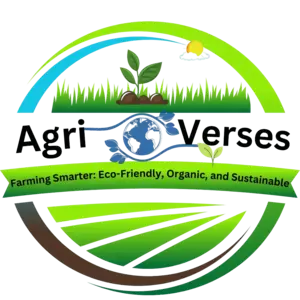
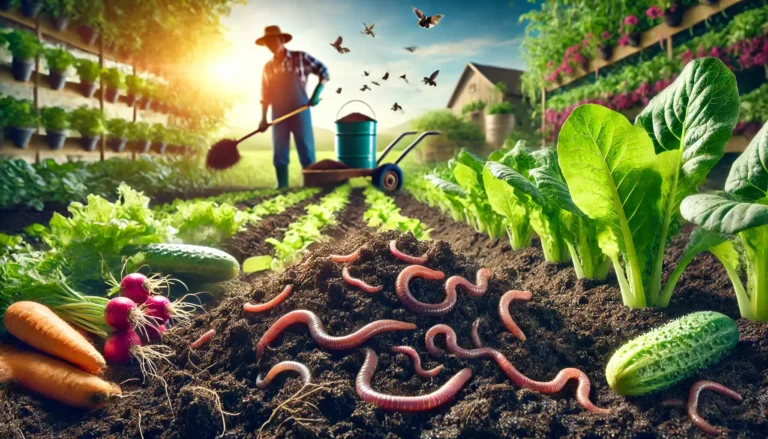
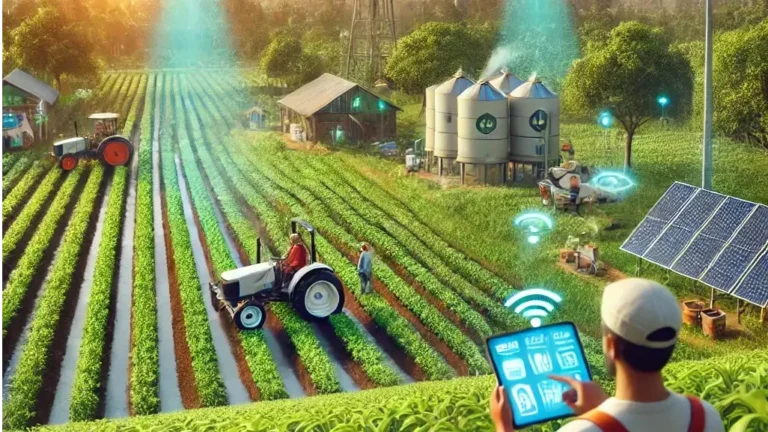
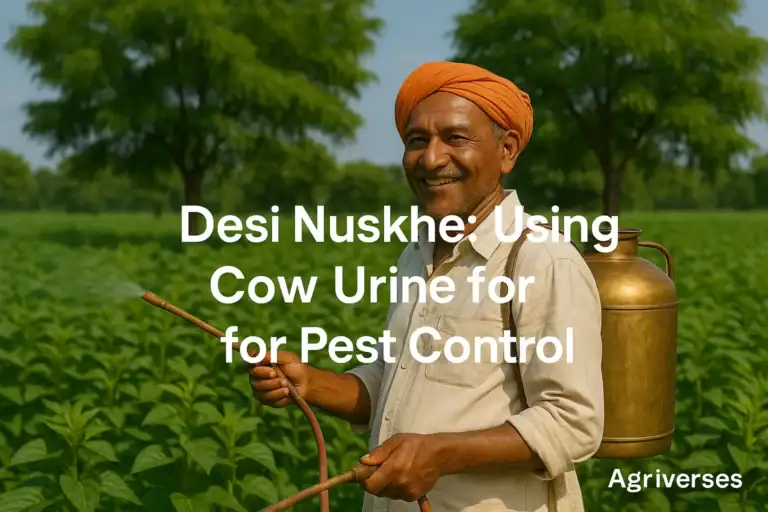
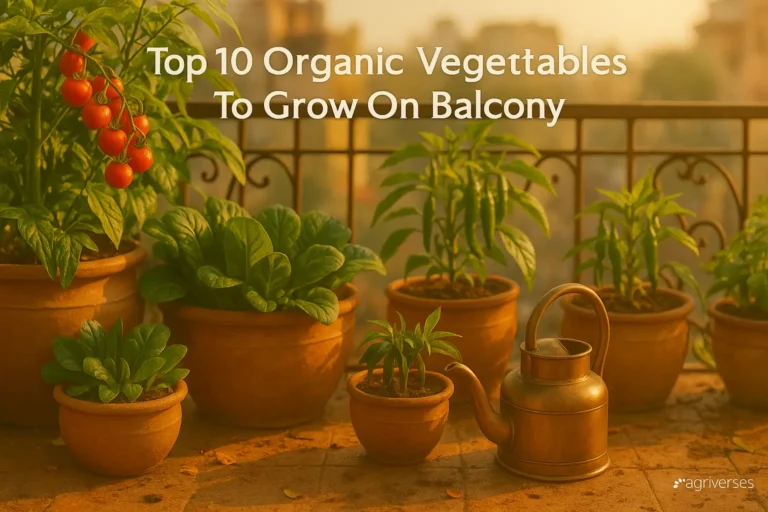


This is actually informative to know that types of organic farming, many websites only mention two types of organic farming. In this article includes othes.
Thanks